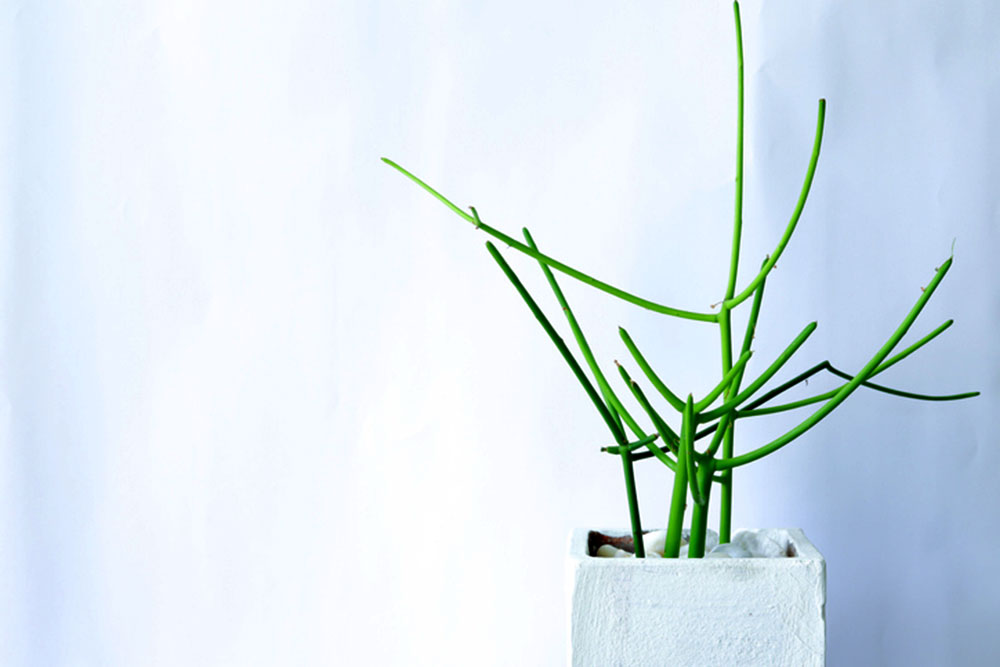
A pencil plant, or pencil cactus, that looks a lot better than the one Stephanie got stuck with. / Photo, here and on the front, from iStock.
By Stephanie Cavanaugh
BRIE WAS ON SALE at Harris Teeter last week. It was lovely stuff, sides softly bulging so you knew it would nearly melt into cream on a cracker.
There were two big wheels; one was sliced in half, each half with a price sticker.
I pointed and asked the young lady behind the counter, Could I have half of that half, please?
(Not that the entire half wouldn’t all be eaten, but buying the whole thing seems so piggish. In situations like this I prefer to return the next day for the other half.)
The young lady looked at me sadly and said, I’m sorry, the slicer is broken.
Let us pause here for just a second to consider the need for a machine to slice the cheese.
How about cutting it with a knife, I said.
She peered at me with wonderment. Would that work?
Yes, I said. It would.
She wandered over to the prep table and hoisted a large knife, inhaled deeply and sliced the slab in two. Wrapping the requested half in plastic, she slapped on a new price sticker and proudly handed it over the counter.
Yay, I said, thinking something less generous. Well done.
That had absolutely nothing to do with plants, flowers, window boxes, vases or anything else gardening-related. I just needed to weed it right out of my head.
This leaves me room to ponder the pencil plant, now sitting unpleasantly on My Prince’s dresser, its skinny limbs flailing about like an orgy of praying mantises. The pencil plant, also known as a pencil cactus, or euphorbia tirucalli if you want to get fancy about it, is a native of South Africa and India, and is a very difficult plant to kill. This I know because I’ve been trying to for several years.
We inherited this unpleasant specimen from our artist friend Jill, who sublet her DC condo, went off to New York for a few years to paint, and left us her windowsill garden to tend. Though she’s been back and forth numerous times since, the plants have remained. They’re so happy with you, she said, or words to that effect.
Among them were several handsome scheffleras, a ponytail palm she’d been growing for decades and is now nearly five feet tall with Rapunzel-length leaf blades. And she left the pencil plant. One could hardly say, I’ll take everything but . . .
But. What an ugly sucker it is. Each summer I put it out in the garden, hide it behind more glamorous shrubbery and hope it will die. Then I can just say, Oops.
Alas, it continues to hang on, and now that I think about it perhaps it’s less a pile of praying mantises and more a mess of middle fingers aimed right at me.
How can you be so cruel to a poor innocent plant, My Prince says. Particularly since it’s Jill’s.
Yeah, and Jill seems really eager to have it back. There is a certain luxury in lending something to a friend while you dash off to art shows and what not, expecting that something to thrive—for years. And if it dies or breaks, you get to blame it on . . . me.
The pencil plant appears to be ailing at the moment, which is exciting. Those wretched, skinny limbs are looking limp and maybe a little brown. The Prince frets. What should I do, he asks me. What could have happened?
And here we arrive at your gardening tip of the week: If you have a pencil plant that you insist on propagating or saving (lord knows why):
- Break off a piece.
- Stick it in some dirt.
- Water
The end.

oops
Maybe I need to come over and have a little conversation with the plant. Thank goodness for the Prince in defending its existence.